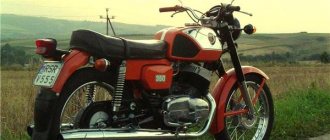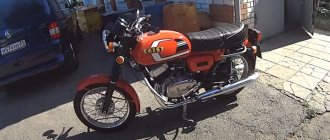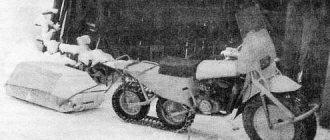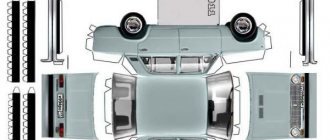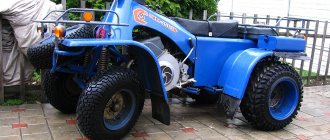To this day, debates about which is better - a car or a motorcycle - continue to rage. But these debates in the 20th century largely concerned developed capitalist countries, where the level of earnings made it possible to choose between a four-wheeled or two-wheeled vehicle.
Did you have a Soviet motorcycle?
NOT REALLY
In the Soviet Union, the picture was simpler - if you can, buy a car, since there is a lot of choice, if you don’t have enough money, then buy a motorcycle.
"Izh-49"
In 1951, production of the Izh-49 model was launched in Izhevsk. As in the case of “Moskva,” they took a captured vehicle as a basis. True, the DKW NZ 350 has undergone some improvements, which only made it better - under our brand, of course.
The motorcycle turned out to be reliable, very durable and incredibly beautiful. Even today it is able to captivate a true biker with its appearance - what a fit, what precise lines... Yes, it was a car!
The plant produced versions with a sidecar, sports versions for cross-country and road racing. Not everyone can afford to own them now: the Izh-49 has collector’s value. You can buy it for no less than 100 thousand rubles. At the same time, the price tends to rise.
New in blogs
Motorcycles “Java” and “Chezet”, a camera “Praktika”, sneakers “Botas”... Just a few decades ago, goods from the countries of the socialist camp were the longed-for dream of millions of our compatriots. To get the treasured item, we were ready to stand in wild queues, sign up on lists, go to night roll calls in accordance with the number that was written on our hands with a chemical pencil, and make acquaintances with the “right” people. Today, the names of most of the “brotherly” brands are practically forgotten. Although some iconic brands of socialist countries are still alive today
New life
The countries of the socialist community exported to us not only consumer goods, but also quite serious equipment. For example, the GDR supplied electronic typewriters, Robotron brand computers and photographic products: Praktika cameras and Orvo film. “Praktika” was the only affordable professional camera in our country and was sold at a very serious price (up to 400 rubles), but even for that kind of money it was very difficult to get it. In 1990, the factory in Dresden, which produced cameras, closed, but resumed operations a year later. As for the Praktika brand itself, it still exists today. You can buy it in our country, but given the current diversity, it has few fans left.
Orvo suffered a similar fate. Back in the early 90s, this brand occupied second place in the world market. But with the collapse of the USSR, the production of photographic film came to a virtual standstill. In 1995, the Orvo factory went bankrupt, and in the same year it was replaced by a factory. Today it produces digital media and chemicals under the Orvo brand.
"Rila" and "Avis"
Today's youth have hardly heard anything about Rila jeans, but their parents probably remember this Bulgarian brand. He was not considered “cool” (even the Indian “Avis” had “more status”). However, for many Soviet people, it was “Rila” that became the only opportunity to feel the “pernicious influence of the West.”
Today this brand is a piece of history. These jeans are not even made in Bulgaria. So if you dig out old pants from your closets, consider them vintage.
But the predecessors of the various “Adidas” there - the Czechoslovakian “Botas” - were much more difficult to get. But there was no happier teenager than the one who got these sneakers. Many of us still remember how comfortable these shoes were compared to our sneakers. She even smelled something special - like a foreign country. By the way, this Czech brand is still alive today. Although now you won’t find Botas sneakers. The company decided to position itself as a manufacturer of skates for hockey and figure skating.
"Enemy" "Java"
Almost all types of transport were supplied to the USSR from the countries of the socialist camp. There were especially many motorcycle brands. The most famous of them is the Czech “Java”. It appeared in our country immediately after the war. Then “Java” was “enemy” - in the pre-war years it was produced for the needs of the German army. But this did not stop the Czech motorcycle from winning the popular love of the Russians. Already in the 60s, every third Soviet motorcyclist rode a Java.
“Java” had no Russian competitors, but the price was too high. So, in the late 70s, “Java” cost 650 rubles. Note that the price of our equipment was two or even three times lower. Today "Java" is still on the move. But this brand no longer has its former popularity. In Russia, its place has been taken by cheap Chinese scooters.
In addition to the Java, another Czech motorcycle was exported to the USSR - the Cheset. It appeared with us a little later than its brother, in the 70s, and was supplied until the end of the 90s. Unlike “Java”, the “Chezet” brand has sunk into history along with the collapse of the Czechoslovak Socialist Republic.
The legendary "member carrier"
Automobile brands of Czechoslovakia deserve a separate discussion. The legendary Czech brand is Tatra. In the early 50s, trams of this brand appeared on the streets of our cities, and in the late 60s - trucks. As for passenger cars, they were represented in our country mainly by “member carriers”. Today Tatra is still present in our market, but its market share is negligible.
It is impossible not to mention the Hungarian brand “Ikarus”. Buses of this brand have been operating in our country since the middle of the last century. Passengers called them “rockets” for their speed and boxy shape. In the early 90s, purchases of Ikarus were sharply reduced, and their production was transferred to Russian factories.
Canned "Globe"
Many food brands from the countries of the socialist camp have survived to this day, although they have lost their former popularity. For example, the Czech beer Pilsen Prazdroj. Today this brand is practically lost among other imported varieties. But in the 1980s, this frothy drink was one of the few foreign beers available.
However, the most famous foreign alcohol, perhaps, was the Bulgarian brandy “Slinchev Bryag”. Now it is almost impossible to find it in our country. In the 90s, “Slinchev Bryag” began to be counterfeited on an industrial scale, after which it completely deteriorated.
Another food brand of socialism is the Hungarian Globus. Canned vegetables and fruits are still produced under this brand. Globus is one of the few “former” brands that managed to gain a foothold in their homeland after all benefits for goods from “brotherly” countries in our country were eliminated.
Now the presence of Globus on our shelves is small. If you try, you can find nostalgic peas, which were once a constant ingredient in the New Year's Olivier salad.
Legendary "Shipka"
In the last century, most people smoked domestic cigarettes. But if you wanted to plunge into foreign smoke, then you bought Bulgarian “BT” (). Although there was a saying then that a chicken is not a bird, Bulgaria is not a foreign country. However, the Bulgarians also supplied us with cheaper products: Shipka, Rodopi, Opal, Tu-134 cigarettes. Now some of these brands can also be bought in our stores.
There were other tobacco brands from friendly countries in the USSR. For example, the Yugoslav “Samuel” and “Europe”, the Hungarian “Kossuth” and the Indian “Madras” (smokers called them “Mattress”). But compared to Bulgarian brands, their popularity was not very great.
Source - izvestia.ru
"Izh Planet"
1962 The Izhevsk Motorcycle Plant is starting to assemble a fundamentally new model for itself, “Izh Planet”, which became the ancestor of a whole family that was produced until 2008 (“Izh Planet 7”).
A middle-class motorcycle created on the basis of the Izh-56 was intended for driving on roads with different surfaces. The warranty mileage of the Izh Planeta has increased by 2,000 km compared to its predecessor, and the service life of the cylinder-piston group parts has increased by one and a half times (thanks to the use of a contact-oil air cleaner).
A new gas tank, easily removable seat, and mufflers were installed. Instead of stamped front and rear wings, stamped-welded ones were used.
The Izh Planet was powered by a single-cylinder, two-stroke air-cooled engine. The crankshaft is prefabricated and pressed. Carter is of block type. The crank chamber is located in the front part, and the gearbox is located in the rear part. The crankcase consists of two halves with a connector along the middle longitudinal plane. The foot shift and kickstart pedals are located on the left side of the gearbox housing.
The motorcycle was produced until 1966, a total of 405,303 copies were produced - a fairly decent circulation for those times.
"Vyatka VP-150"
This is not a motorcycle, but the path associated with it is not very long, but, nevertheless, an era in the life of the country.
In 1956, designers of the Vyatsko-Polyansky Machine-Building Plant, together with specialists from the Central Experimental Design Bureau (TsEKB) of motorcycle manufacturing from Serpukhov, Moscow Region (now OJSC Motoprom), began work on a 150 cm³ class scooter.
Time was running out, and there was no experience in creating such devices. Therefore, the Italian Vespa 150GS scooter from 1955 was taken as a prototype. Measurements were taken from it, and drawings were made based on the finished scooter.
Let us remind you that Vespa (Italian wasp, hornet) is an iconic Italian scooter, which has been produced by the Piaggio concern since April 1946 until now. The founder of the European design school of motor scooters, the first successful scooter in the world.
This device was incredibly beautiful, had a quiet and smooth ride. Even women could easily control it.
By the way, on the basis of Vyatka they made a whole range of three-wheeled scooters with different bodies. They served as commercial vehicles for the delivery of compact cargo - lightweight, economical, maneuverable.
Postscript . Almost every model that we talked about deserves a separate historical essay. In this case, we did not set such a goal, limiting ourselves to a quick review, which, we hope, gave some idea of what our grandfathers, fathers, and sometimes ourselves, rode.
Photo: Internet resources
How many motorcycles were there in the USSR?
From 1954 to 1975 in the USSR there was
286,959
motorcycles
. The most popular model was the Pannonia 250 TLF.
Interesting materials:
How to calculate the date of maternity leave? How to calculate the effective date of a court decision? How to calculate the date of maternity leave? How to calculate the pressure at the bottom of a well? How to calculate maternity benefits up to 1.5 years? How to calculate the length of the dowel? How to calculate the length of linoleum in a roll? How to calculate the length of a wall knowing the area? How to calculate the length of the rafters of a gable roof? How to calculate the length of a fence?
"M-62"
In the 50s and 60s of the last century, the Soviet police actively used in their work motorcycles with the M-62 sidecar, which were produced by the Irbit Motorcycle Plant. The four-stroke engine of this car produced as many as 28 “horses”.
By the way, ordinary citizens of the USSR were not allowed to operate Urals without a sidecar at that time. The fact is that these motorcycles were quite difficult to control. But the police rode them without wheelchairs, which looked very cool.
"M-62" can be seen in the film "Beware of the Car", it was especially good in the scene of the chase of the "twenty-first" Volga, stolen by the Soviet Robin Hood Yuri Detochkin.
"Sunrise"
In 1957, Voskhod motorcycles began to be produced in the city of Kovrov, Vladimir Region. Very unpretentious, with a single-cylinder engine of 173.7 cubic meters, they appealed to the motorized public.
In addition, the Dyagterev plant constantly modernized this model, producing versions “Voskhod-2”, “Voskhod-3”, “Voskhod-3 M”. The latest Voskhod motorcycle was the 3 M-01 model with a 15 horsepower engine.
Externally, the Voskhods were inferior to the Izhams, but thanks to their reliability, they became indispensable in the countryside. To this day, you can find Voskhod in Russian villages. And not just meet, but go for a ride.
History of motorcycles Minsk
3.18 / 5 (22 votes)
Motorcycle production in Minsk dates back to 1951. The prototype was the German model DKW RT125, which had been in service with the Wehrmacht since 1941.
By decision of the Allies, any enterprise that supplied weapons to the Wehrmacht was subject to dismantling. Therefore, as compensation for the damage caused to the national economy of the USSR, technical documentation and equipment from the DKW plant in the city of Zschopau were exported to the country. But there was still a lot of work - it was necessary to translate the documentation into Russian, select analogues from domestic materials, and organize the production of components.
The production of the RT125 model began in Kovrov (“K-125”) and in Moscow (“M1A”).
In 1951, the first Minsk motorcycle “M1A” was released - compact and single-seater, with an unsprung rear wheel - the shock was softened by two spiral springs of the saddle. At the front, a parallelogram fork with a single spring was used, and 19-inch wheels with stamped steel hubs. The engine cylinder was cast iron, a simple mesh air filter was equipped with a starting mesh air filter and a starting flap, and the electrical equipment included a DC generator and battery. The engine ran on A-66 gasoline and the transmission had three gears. On a nine-liter tank it was possible to travel up to 400 km, largely due to the lack of rear suspension, which limited the speed to 40-50 km/h (although the maximum speed was 70 km/h). The engine size (bore/stroke) was 52/58 mm, which has remained unchanged to this day.
The first motorcycles in Minsk were assembled from Moscow components, which explains the inscription “Moscow” on the gas tank. The M1A motorcycle (popularly dubbed the “Macaque”) even today looks proportionate and elegant, despite the absence of any cladding.
The success of the choice of prototype is evidenced by the fact that by 1950, eight factories in seven countries were producing copies of this German model. Including such famous motorcycle companies as BSA, Harley-Davidson, Royal Enfield and Yamaha. In Minsk, destroyed by the war, on November 6, 1945, a restored bicycle plant came into operation, the equipment for which was also exported from Germany. By order of the Ministry of Automotive and Tractor Industry of the USSR No. 494 of July 12, 1951, the production of the M1A motorcycle was transferred from Moscow to Minsk. This is how the Minsk Motorcycle and Bicycle Plant (MMBZ) appeared. The plant still operates today, and its commitment to the production of motorcycles has remained intact.
The modernized M1M motorcycle, which appeared in 1956, stood out for its original shape of deep welded fenders.
It received a pendulum suspension of the rear wheel with spring shock absorbers and friction dampers (vibrations were damped by dry friction between the washers). The parallelogram front fork gave way to a short-link pusher type with spring shock absorbers. Now the suspension has become very soft; it was even noted that on bad roads it worsened stability. Electrical equipment running on alternating current was used for the first time on a motorcycle. The engine power increased slightly due to changes in the manufacturing technology of purge channels in cast iron cylinders, an increase in the compression ratio and the use of a different carburetor. And the muffler lost the “fish tail” typical of pre-war motorcycles.
In 1961, the designers of the M-103 model summarized the design experience they had gained, experience in participating in sports competitions, and experience in long-term operation. The result was the “Humpbacked Horse,” on which a telescopic fork with “hydraulics” was installed. Hydraulic shock absorbers were also used in the rear wheel suspension. The wings are profiled again and are not as deep as before. Instead of a mesh air filter, a contact oil filter was installed, which significantly improved air purification and increased the durability of engine parts. It is believed that the M-103 was the simplest Minsk motorcycle. Although its load capacity was 150 kg, the seat was a single seat, the saddle and passenger footpegs had to be purchased separately.
When creating the M-104 motorcycle in 1964, special attention was paid to issues of technical aesthetics. The device now has side trims, a double seat, and a carburetor and filter casing. This car was the first to receive its own name “Minsk”. Engine power increased to 5.5 liters. With. due to an increase in the compression ratio and a modernized K-55D carburetor. At the same time, the engine, compared to its predecessors, lost its flexibility in characteristics (and the gearbox remained three-speed), which prompted the designers to develop a new engine.
In 1967, the M-105 model was released. In terms of the number of design changes and their labor intensity, the M-105 model has no equal among Minsk motorcycles. A new engine that produced a significant 7 hp at that time. With. and allowing acceleration to 80 km/h, became the base for subsequent models. Its main differences: an aluminum cylinder jacket with a cast iron liner poured into it, a new K-36M carburetor and muffler, and a four-speed gearbox. The main drive chain began to be covered with stamped casings with rubber covers. For the first time, a brake light was installed on the M-105, as well as a speedometer backlight. The frame was strengthened somewhat, but the rest of the chassis and hood components remained virtually unchanged. One of the M-105 models became the millionth Minsk motorcycle.
In 1971, the M-106 model was released; the cylinder and head with an increased fin surface and a new shaped gas tank stood out. The tank volume increased to 12 liters, and an emblem in the form of a stylized image of a stork appeared on the sides. The engine power was increased to 9 hp. With. due to better cylinder filling, new muffler and carburetor. Increasing power and increasing the maximum speed to 85 km/h required further strengthening of the frame and replacement of wheel bearings. For the first time, a trunk was installed, which later became a mandatory accessory for Minsk motorcycles. The weight of the car reached 100 kg.
Released in 1973, the MMV3-3.111 model stood out for its modern appearance thanks to the liquidity of the linings, the original shape of the gas tank, tool boxes and engine crankcase covers. Improvements also affected a number of other components and parts. Now aluminum wheel hubs were installed on motorcycles, and the wheels themselves came with a landing diameter of 18 inches. The air filter received a paper filter element, a central light switch and a direction indicator appeared. The motorcycle received the USSR Quality Mark. A small series was produced of the “Sport” modification, which was distinguished by a sports steering wheel with a jumper, an upper muffler and a front fender. The trunk and steering damper were removed from the motorcycle, an electronic ignition system was used for the first time on Minsk motorcycles and they switched to AI-93 gasoline, which provided a maximum power of 11.5 - 12.5 hp at a compression ratio of 12.
In general, the appearance of the MMV3-3.115 motorcycle, which appeared in 1976, has changed little compared to its predecessor. A new muffler, headlight and taillight have been installed. The central switch and speedometer were moved out of the headlight housing into separate housings. Since 1977, non-contact electric ignition with a KET-1 switch and a new K-62S carburetor began to be installed on the motorcycle. This made it possible to increase engine power without switching from AI-72 to higher octane gasoline. Since the MMV3-3.115 model, Minsk motorcycles have lost their steering damper forever, and rebound springs have appeared in the front fork. The MMV3-3.115 motorcycle is considered one of the most successful at the enterprise - it was produced for seven years.
1982 The MMVZ-3.112 motorcycle, which has remained virtually unchanged in appearance, has improved its consumer qualities in a number of ways. It became 7 kg lighter, the diameter of the brake drums increased to 150 mm. A new feature was the separation of the rear wheel hub from the sprocket - now when removing the wheel there was no need to remove the chain drive.
The modernization of 1984 most affected the electrical equipment system - they switched to a voltage of 12 V, and the generator power increased to 65 W. A voltage stabilizer appeared, combined with an ignition system switch, the so-called BKS. Control indicators for direction, high beam, and neutral gear appeared on the dashboard. The gear ratios in the gearbox have also been changed.
1986 ММВ3-3.112.11, this modification of the motorcycle was intended for use primarily in rural areas. The engine was derated to 10 hp. s., but at the same time it became more torquey at low speeds. Light traffic on rural roads was ensured by the main gear ratio increased to 3.07. The new muffler has been designed to raise the rear end for increased off-road capability. The raised front wing also served the same purpose. The gas tank lost its rubber lining, and a jumper appeared at the steering wheel.
The 1991 modification of the MMV3-3.112.12 motorcycle for rural areas was equipped with a new instrument panel and efficient single-tube gas-filled shock absorbers for the rear suspension.
The 1992 motorcycle MMB3-3.112.13 differed from its predecessors primarily in the front fork - the diameter of the supporting pipes increased to 35 mm, and the sliding pipes began to be made of aluminum alloy, the settings changed, and rubber corrugations appeared. The front “upper” wing became plastic, the muffler changed its shape, became thinner and longer, and the technology for its manufacture changed.
The 1994 modification MMV3-3.113 was the most heavily updated model of the M-105. For the motorcycle, a duplex wheel suspension frame, saddle, gas tank, rear fender, facings, and air filter were redesigned. The front fork and muffler were carried over from the 3.112.13 model introduced several years ago. The driver's position has changed - the height of the saddle has increased. We used a cable drive for the rear brake. The engine's crankcase, cylinder, and cylinder head were redesigned, and a new design generator was installed - a flywheel. The engine power (the same size 52/58 mm as the M1A) reached 13 hp. s., this highest figure for all serial Minsk models made it possible to overcome the symbolic speed mark of 100 km/h.
1996, MMV3-3.113.1, an outwardly indistinguishable modification received an engine that, in order to improve performance at low speeds, was derated to 10 hp. With.
In 1999, the MMV3-3.112.14 model was released, a motorcycle with the name “Sputnik” was a modification of the 3.112.12 model and differed from it in the headlight (later a rectangular headlight with a halogen lamp and an Iranian-made fairing was installed on it). The muffler is borrowed from the “one hundred and thirteenth” model.
MMV3-3.114 of 2003 became the first Minsk motorcycle with a four-stroke engine. This 125 cm3 engine was equipped with an electric starter, the transmission was a five-speed gearbox and an open chain drive located on the left. A monotube frame was designed for the engine, which has a pedigree from the Honda CB125. In addition to the engine, the MMV3-3.114 differed from the MMV3-3.113.5 by inclined rear shock absorbers, an imported air filter with a foam filter element, and a muffler. The brakes on both wheels remained drum brakes; in 2008, a disc brake was installed at the front. In recent years, the model has been called MINSK C4 125.
The 2005 MMV3-3.113.4 motorcycle was designed for use in forestry. It had increased off-road capability due to increased suspension travel (due to raked rear shock absorbers), and the layout allowed for a rear tire with wider tread. A special feature of the motorcycle is its numerous attachments: an enlarged rear trunk, side and front racks, a removable passenger seat, crash bars, headlight and front turn signal protection. Cassettes for fire extinguishers and driver hand protection were optionally available.
2006 MMV3-3.113.8, this modification differs from 3.113.5 by inclined rear shock absorbers, a raised muffler and plastic side trims. Instead of imported components (headlight, fairing, wing, etc.), domestic ones were used. In recent years, the model has received the designation MINSK C125.
The design of the motorcycle in 2008 MINSK M4 200 was made in a classic style; customizer Yuri Shif had a hand in the appearance. The installed engine is a 200 cc engine produced by the Chinese company Zongshen. The retro motorcycle attracts with its simplicity and traditionality combined with elegance of form.
In the latest models, since 2008, 52 changes have been made to the classic models, after which they received new names - “C125”, “M125”, “M125X”, etc. Including: restyling was carried out and the color range of motorcycles was expanded, painting technology was improved, the engine and gearbox were improved, a new flywheel-type generator with increased power was installed. Motorcycles are equipped with new chains, light elements, and wind shields. At the customer's request, the front wheel is equipped with a disc brake.
MINSK M125 2009, in fact it is the MMVZ-Z.112.15 “Pioneer” produced since 1999, equipped with a front disc brake and with minor changes in the configuration. A stork flew away from the emblem on the gas tank.
The classic 2010 MINSK X200 SUV will appeal to novice motorcyclists. Nothing superfluous - just the essentials for conquering dirt roads and forest trails. The presence of lighting equipment and dual-use tires allows you to move comfortably on public roads.
The 2011 MINSK C4 250 is built on a completely new platform, it has a modern appearance, alloy wheels and dual-disc front brakes.
MINSK R250 2012 is a development by Megelli, introduced into production without simplification or reduction in cost.
The engine is water-cooled and has a six-speed gearbox.
It is estimated that over the 60 years of the company’s existence, more than 6.5 million motorcycles were sold. And this figure is not final; the management and employees of the enterprise are optimistic about the future.
"Izh Planet Sport"
In 1973, Izhevsk again delighted the country's motorcyclists by releasing the first Soviet motorcycle with a sporty character. The model was called “Planet Sport”.
Interestingly, unlike all earlier motorcycles, which were created in the image and likeness of German models, Planet Sport had something in common with Japanese motorcycles of the 60-70s of the last century.
Izh Planet Sport has made a serious step towards build quality. Thanks to this, it was actively sold in export markets. The car was evaluated in the UK, the Netherlands and Finland. They say that Soviet bikers accelerated on this device to 140 km/h!

